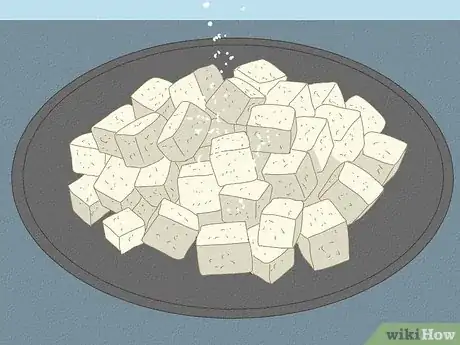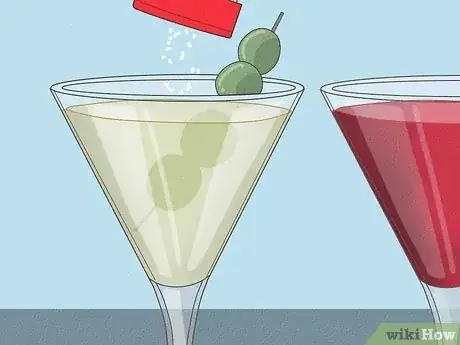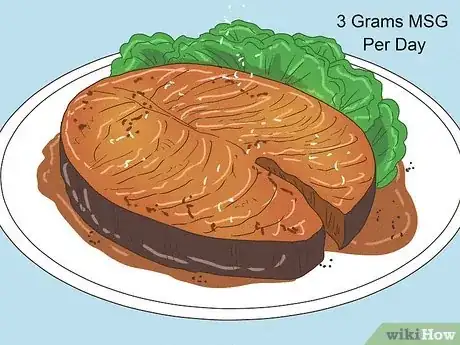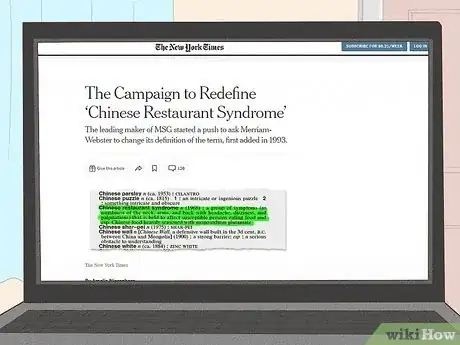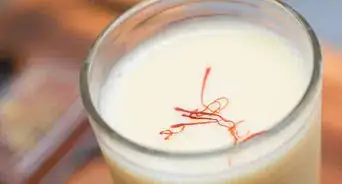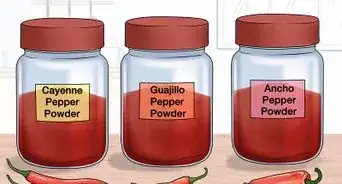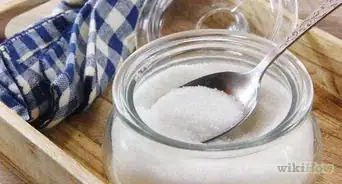This article was co-authored by wikiHow staff writer, Luke Smith, MFA. Luke Smith is a wikiHow Staff Writer. He's worked for literary agents, publishing houses, and with many authors, and his writing has been featured in a number of literary magazines. Now, Luke writes for the content team at wikiHow and hopes to help readers expand both their skillsets and the bounds of their curiosity. Luke earned his MFA from the University of Montana.
There are 11 references cited in this article, which can be found at the bottom of the page.
This article has been viewed 3,637 times.
Learn more...
MSG (Monosodium glutamate) is something of a culinary boogeyman. For years, western foodies have been hesitant to use or even consume the seasoning, even if it’s as common as salt in eastern regions. But popular myths are just now starting to be dispelled, and it’s high time we welcomed MSG into our pantries and our hearts. But… how? What do you even use it for? Allow us to introduce you to the wonderful world of MSG. We’ve put together a handy primer on how to cook with MSG, what exactly MSG is, and why it’s gotten such a bad rap. Let’s get cooking.
Things You Should Know
- Season foods like poultry, fish, vegetables, and even cocktails with a dash of MSG, to taste.
- MSG is a naturally occurring compound discovered in 1908, and is found in foods like tomatoes and many cheeses.
- The FDA considers MSG safe to consume, and its bad reputation is the result of unfounded rumors.
Steps
Cooking with MSG
-
1Season meats and fish with a touch of MSG. You may think you know all there is to know about poultry and fish flavors, but you can add a surprising amount of new depth by sprinkling a bit of MSG over the dish while you cook or even as you serve the dish. Here, MSG will add a touch of saltiness and round out and embolden the savory qualities of the meat. Use it like you would use salt: sparingly, but to taste.[1]
- Add half a teaspoon (about 2.5ml) of MSG to your sauces and marinades to help their natural flavor better absorb into the meat.[2]
- Try using MSG as part of a dry rub to season chicken, skirt steaks, or fish filets.
-
2Use MSG to boost the flavor of vegetarian or vegan foods. It can be a little tricky to achieve full, robust flavors on a plant-based diet, but MSG is here to help. Add a pinch of MSG (or however much you prefer) to vegetables or plant-based foods like tofu. It’ll introduce some of those umami flavors you’ve been missing from meat dishes, and kick up the natural flavors of the recipe.[3]
- MSG can cut acidity and up sweetness in vinaigrettes and vegetables to offer a smoother, less aggressive flavor to your salad, while spotlighting the natural flavors of your veggies.
- Sprinkle MSG on fruit-based dishes to up their sweetness without having to resort to plain sugar.[4]
Advertisement -
3Mix MSG with salt to make a powerful and versatile seasoning. In a small bowl, whisk together 10 parts of Kosher salt and 1 part of MSG. Since MSG doesn’t have a ton of flavor on its own (it’s a flavor booster, after all), the salt acts as a convenient vehicle to delivering the umami profile to any dish, while also seasoning it as you would normally.[5]
- Because MSG has less sodium than salt, and because it’s a flavor booster, this mixture has the added benefit of cutting sodium from your diet; use less of this seasoning mix than you would plain salt. Reap the benefits without cutting the flavor.[6]
- You can also do the reverse and use MSG to season food without salt. True, it might not hit your cravings the same, but it can help you cut back on sodium and discover even more flavor profiles.
-
4Add MSG to your cocktails. No, really. We’re serious. Manhattan? Better with MSG. Dirty Martini? You better believe a little MSG will complement that olive brine nicely. A conservative pinch of MSG accents any savory-salty libation with just a touch of umami for extra complexity and depth.[7] Keep some MSG on-hand when making cocktails, and drink responsibly!
- MSG is a pro at rounding off the corners of bitter flavors, which makes MSG the MVP in making many mixed drinks even more drinkable.[8]
- Also try a dash of MSG in fruitier cocktails, like grapefruit or other citrus-infused drinks made with gin, tequila, or even soju.
What is MSG?
-
1MSG is a naturally occurring kind of salt. More specifically, it’s the sodium salt of glutamic acid, which is a common amino acid. We have glutamic acid present naturally in our bodies, and MSG occurs naturally in a huge range of foods, like tomatoes and cheeses. That’s all to say that there’s nothing strange or unnatural about this tasty little seasoning.[9]
-
2Kikunae Ikeda first discovered MSG in 1908. Ikeda was a biochemist trying to figure out just what gave one of his favorite soup broths its strong and savory qualities, and in the process discovered that the broth had a healthy heaping of glutamic acid.[10] From glutamic acid, Ikeda isolated and patented MSG as a table seasoning.[11]
- MSG was already being used widely in Japan by 1909, and was commonly produced by the brand Aji-no-moto, which still makes MSG you can buy today.
-
3MSG is part of the umami flavor profile. Before Kikunae Ikeda coined the term “umami” (which means “delicious” or “yummy”), there were only 4 commonly accepted profiles: sweet, salty, bitter, and sour. Ikeda used “umami” to describe the savory qualities of foods like fish, meat, and certain vegetables. MSG happens to be a potent umami booster.[12]
Common Misconceptions
-
1MSG isn’t bad for you. At least, not more than any other seasoning or spice. Just like you can have too much sodium in your diet, you can have too much MSG. But otherwise, MSG has been added to the FDA’s “generally recognized as safe” (GRAS) list, so you’re good to go when it comes to the umami additive. As they say, everything in moderation.[13]
- In addition, MSG hasn’t been linked to obesity or raised cholesterol. It has been found to possibly cause a higher BMI over time (Body Mass Index), but some experts think that could be because it just makes food too tasty to resist.[14]
- It’s not recommended that you consume 3 grams (0.11 oz) of MSG a day (and that number refers to MSG consumed without food), but that amount is difficult to hit, and most foods with added MSG only have about 0.5 grams (0.018 oz) per serving.
-
2Allergic reactions to MSG aren’t common. Worries and fears around MSG center around reports of headaches, weakness, or numbness when consuming MSG, but the FDA hasn’t been able to link those symptoms to the seasoning. True, some people may have MSG sensitivities, but different people have different sensitivities to any given food, like peanuts or corn, so MSG isn’t especially dangerous or harmful.[15]
-
3Negative perception of MSG began with a rumor. It started when the New England Journal of Medicine published a letter in 1968 which claimed that the writer had a negative reaction to food he consumed in a Chinese restaurant. Readers concluded MSG was to blame, but even the writer of the letter admitted it could have been any number of foods.[16]
References
- ↑ https://www.bonappetit.com/story/give-msg-a-chance
- ↑ https://www.knowmsg.com/wp-content/themes/whyusemsg/assets/pdfs/Sodium-Handout.pdf
- ↑ https://www.bonappetit.com/story/cooking-with-msg
- ↑ https://www.knowmsg.com/wp-content/themes/whyusemsg/assets/pdfs/Sodium-Handout.pdf
- ↑ https://tastecooking.com/how-to-cook-with-msg/
- ↑ https://www.thekitchn.com/could-msg-help-you-eat-more-healthy-food-241486
- ↑ https://punchdrink.com/articles/your-martini-missing-msg/
- ↑ https://www.knowmsg.com/wp-content/themes/whyusemsg/assets/pdfs/Sodium-Handout.pdf
- ↑ https://www.fda.gov/food/food-additives-petitions/questions-and-answers-monosodium-glutamate-msg
- ↑ https://www.seriouseats.com/ask-the-food-lab-the-truth-about-msg
- ↑ https://www.fda.gov/food/food-additives-petitions/questions-and-answers-monosodium-glutamate-msg
- ↑ https://www.foodnetwork.com/healthyeats/healthy-tips/2009/02/umami-the-5th-taste
- ↑ https://www.fda.gov/food/food-additives-petitions/questions-and-answers-monosodium-glutamate-msg
- ↑ https://health.clevelandclinic.org/is-msg-really-harmful/
- ↑ https://www.fda.gov/food/food-additives-petitions/questions-and-answers-monosodium-glutamate-msg
- ↑ .https://www.foodnetwork.com/fn-dish/news/know-msg-label
- ↑ https://tastecooking.com/how-to-cook-with-msg/

